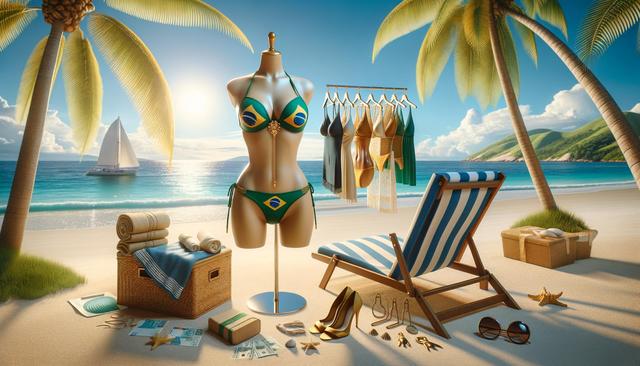The Cultural Roots of Minimal Swimwear
To understand why Brazilian bikini swimsuits are smaller than many might expect, it’s important to consider the cultural backdrop in which they emerged. Brazil’s beach culture is deeply ingrained in its national identity. Cities like Rio de Janeiro and Salvador thrive on a beach lifestyle that celebrates the human form in an open and confident way. In this context, swimwear is not merely functional but part of a broader fashion and self-expression movement.
In Brazilian culture, showing skin is often associated with confidence, beauty, and pride in one’s appearance. The smaller cut of Brazilian bikinis reflects these values and is designed to accentuate natural body shapes rather than conceal them. The style became prominent in the 1970s and 1980s, aligning with global changes in fashion and body positivity.
Moreover, Brazil’s warm climate and vibrant beach life contributed to the evolution of this swimwear. With high temperatures and a social atmosphere centered around sunbathing and swimming, less fabric simply made sense for comfort and practicality.
Fashion Trends and Global Influence
Brazilian bikinis have significantly influenced international swimwear trends. Over the past few decades, their popularity has grown beyond Brazil’s borders, thanks in part to the global fashion industry and the rise of social media. Influencers and models have often showcased this style, making smaller bikini designs more mainstream worldwide.
The design of Brazilian bikinis typically includes:
- Thong or cheeky bottoms that provide minimal coverage
- Triangle-shaped tops with narrow straps
- High-cut leg designs that elongate the silhouette
These features are not just about aesthetics—they also align with the current fashion preferences that favor bold and body-positive clothing. As a result, many swimwear brands from different countries have adopted similar cuts and patterns, highlighting the widespread acceptance of this once uniquely Brazilian trend.
Practical Reasons Behind the Design
Beyond cultural and fashion motivations, there are also practical reasons why Brazilian bikinis are designed with less material. The smaller size allows for better tanning, as more skin is exposed to the sun. Many beachgoers prefer this for achieving an even, minimal tan without significant tan lines.
Additionally, a minimalist design makes movement easier, which is especially beneficial for Brazil’s active beach lifestyle involving sports like beach volleyball, surfing, and swimming. Lightweight materials and streamlined cuts reduce drag and increase comfort during physical activity.
From a production standpoint, smaller bikinis also require less fabric, which can reduce manufacturing costs and environmental impact. This practicality makes them not only fashionable but also efficient from a design and sustainability perspective.
Body Image and Confidence
The design of Brazilian bikini swimsuits also ties closely to how body image is perceived in Brazil. Unlike in some cultures where modesty is emphasized, Brazilian standards often center on self-confidence and body acceptance. Wearing a smaller bikini is not necessarily about having a certain body type—it’s about embracing the one you have and presenting it with pride.
In fact, Brazilian swimwear designers often create options for a variety of body shapes, ensuring that the minimalist aesthetic is accessible to all. Key elements that support this inclusivity include:
- Stretchable fabrics that adapt to different sizes
- Adjustable straps for a customized fit
- Designs that highlight natural curves
This approach promotes a positive body image and encourages wearers to feel comfortable in their own skin, which is a central theme in Brazil’s beach culture.
Adapting Brazilian Styles Abroad
While Brazilian bikinis are gaining popularity globally, they are often adapted to suit varying cultural norms and preferences. In some countries, the original designs may be considered too revealing, leading to modified versions that retain the essence of the style while offering more coverage.
These adaptations may include:
- Wider bottom cuts for more coverage
- Longer tops or crop-top styles
- High-waisted options for a retro-modern blend
Such variations help make the Brazilian bikini style more versatile and accessible in international markets. Despite these changes, the core appeal—confidence, aesthetics, and practicality—remains intact. As a result, the influence of Brazilian swimwear continues to grow, offering a range of choices that cater to diverse tastes and comfort levels.
Conclusion: Embracing the Brazilian Bikini Philosophy
Brazilian bikini swimsuits represent more than a fashion statement—they reflect a lifestyle rooted in confidence, practicality, and cultural pride. While the smaller cut might initially surprise some, it serves a purpose that aligns with Brazil’s climate, beach culture, and values of body positivity. For those exploring new swimwear styles, understanding the reasons behind the design can lead to greater appreciation and comfort in embracing this renowned fashion trend. Whether you adopt the classic look or a more modest variation, Brazilian bikini styles offer a unique blend of function and flair for modern beachgoers.


